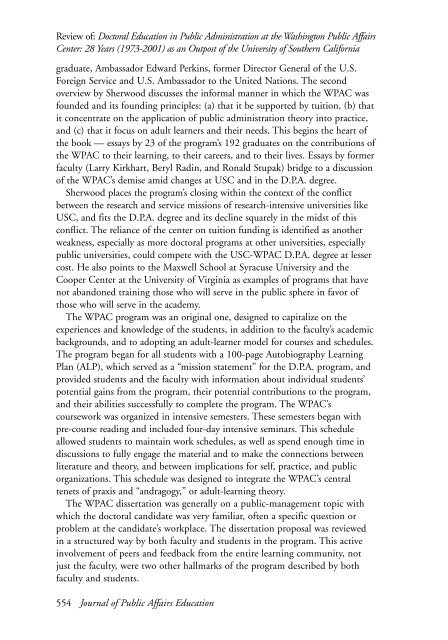JOURNAL OF PUBLIC AFFAIRS EDUCATION - National ...
JOURNAL OF PUBLIC AFFAIRS EDUCATION - National ...
JOURNAL OF PUBLIC AFFAIRS EDUCATION - National ...
You also want an ePaper? Increase the reach of your titles
YUMPU automatically turns print PDFs into web optimized ePapers that Google loves.
Review of: Doctoral Education in Public Administration at the Washington Public Affairs<br />
Center: 28 Years (1973-2001) as an Outpost of the University of Southern California<br />
graduate, Ambassador Edward Perkins, former Director General of the U.S.<br />
Foreign Service and U.S. Ambassador to the United Nations. The second<br />
overview by Sherwood discusses the informal manner in which the WPAC was<br />
founded and its founding principles: (a) that it be supported by tuition, (b) that<br />
it concentrate on the application of public administration theory into practice,<br />
and (c) that it focus on adult learners and their needs. This begins the heart of<br />
the book — essays by 23 of the program’s 192 graduates on the contributions of<br />
the WPAC to their learning, to their careers, and to their lives. Essays by former<br />
faculty (Larry Kirkhart, Beryl Radin, and Ronald Stupak) bridge to a discussion<br />
of the WPAC’s demise amid changes at USC and in the D.P.A. degree.<br />
Sherwood places the program’s closing within the context of the conflict<br />
between the research and service missions of research-intensive universities like<br />
USC, and fits the D.P.A. degree and its decline squarely in the midst of this<br />
conflict. The reliance of the center on tuition funding is identified as another<br />
weakness, especially as more doctoral programs at other universities, especially<br />
public universities, could compete with the USC-WPAC D.P.A. degree at lesser<br />
cost. He also points to the Maxwell School at Syracuse University and the<br />
Cooper Center at the University of Virginia as examples of programs that have<br />
not abandoned training those who will serve in the public sphere in favor of<br />
those who will serve in the academy.<br />
The WPAC program was an original one, designed to capitalize on the<br />
experiences and knowledge of the students, in addition to the faculty’s academic<br />
backgrounds, and to adopting an adult-learner model for courses and schedules.<br />
The program began for all students with a 100-page Autobiography Learning<br />
Plan (ALP), which served as a “mission statement” for the D.P.A. program, and<br />
provided students and the faculty with information about individual students’<br />
potential gains from the program, their potential contributions to the program,<br />
and their abilities successfully to complete the program. The WPAC’s<br />
coursework was organized in intensive semesters. These semesters began with<br />
pre-course reading and included four-day intensive seminars. This schedule<br />
allowed students to maintain work schedules, as well as spend enough time in<br />
discussions to fully engage the material and to make the connections between<br />
literature and theory, and between implications for self, practice, and public<br />
organizations. This schedule was designed to integrate the WPAC’s central<br />
tenets of praxis and “andragogy,” or adult-learning theory.<br />
The WPAC dissertation was generally on a public-management topic with<br />
which the doctoral candidate was very familiar, often a specific question or<br />
problem at the candidate’s workplace. The dissertation proposal was reviewed<br />
in a structured way by both faculty and students in the program. This active<br />
involvement of peers and feedback from the entire learning community, not<br />
just the faculty, were two other hallmarks of the program described by both<br />
faculty and students.<br />
554 Journal of Public Affairs Education

















